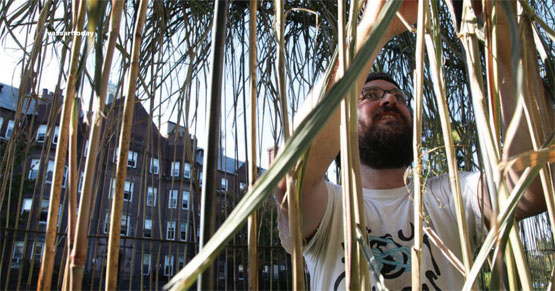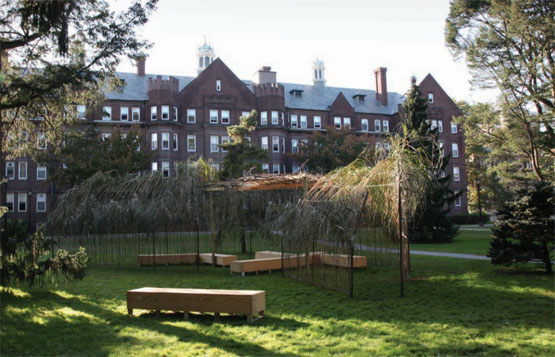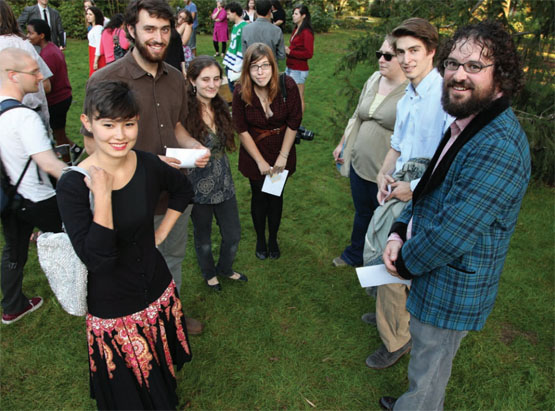A Shelter, Fragile Yet Strong

It was a joyous time. A group of alumnae/i, students, faculty, and administrators had assembled in front of the Students Building (aka ACDC) on a warm fall afternoon to kick off the Jewish festival known as Sukkot. Named for the plural form of sukkah (booth), the festival is both a reminder of the fragile dwellings used during the Israelites’ 40-year exodus from Egypt and a remembrance of agricultural bounty and the huts Jews built near their fields during harvest.
For the occasion of the college’s Sesquicentennial—and inspired by a sukkah design competition held in New York City’s Union Square Park in 2010—the Office of Religious and Spiritual Life invited Studio Art majors to design two sukkot.
The sukkah is a booth in which meals, prayers, and even sleeping are carried out for the festival’s duration. Halakhah, Jewish law, dictates myriad requirements for the ritual structure. It must be outdoors and comprise at least three walls. The sechach (roof) should consist of raw, unfinished plant matter—bamboo, corn stalks, reeds, tree branches. It must be open enough to see the night sky and stars above, yet provide shade to its inhabitants from the midday sun.
Art professor Tyler Rowland ’00 assembled a team of five who called themselves “Team Sukkah 5772” (for the Hebrew calendar year): Matthew Kramer ’13, Noah Lourie Mosher ’12, Kristin Regler ’12, Samantha Shin ’12, and Sierra Starr ’12. It was a project that blended art, architecture, engineering, and, for some, religion.

The process began at the beginning of the fall 2011 semester. Team members first collaborated on a shared, collective design. “It was like a puzzle,” says Mosher, “figuring out how to put it all together.” The second challenge was actually building the sukkot. Almost everything was built from scratch, including custom welding and fabricating.
The result was two unconventional and artistic sukkot, which could be thought of “more as sculpture and less as architecture,” notes Rowland.
The smaller sukkah comprised a series of seven squares, ranging in size from 2 to 10 feet tall. Recycled two-by-fours formed the frames. More than half a mile of red and brown twine created circular entrances as well as a pattern of interwoven strands that resembled a bird’s nest. Tree branches formed the roof, while a large tree stump served as a central bench and seating area inside.
The larger sukkah measured more than 75 feet long. Wooden beams formed a Star of David, on which Team Sukkah 5772 placed palm fronds and tree branches to form the roof. Beneath it, team members arranged a series of seven wooden benches. A dedicated campus telephone extension was posted in the sukkah; visitors could hear students reading anecdotes by Jewish alumnae/i by dialing the number on their cell phones.
The walls consisted of a steel frame hidden by reeds. Team Sukkah 5772 and volunteers from the Vassar Jewish Union (VJU) harvested more than 2,000 phragmites plants (an invasive species) from wetlands on Vassar’s campus. “It was a community harvest, an authentic experience,” says Mosher.
The intermingling of steel with supple marsh reeds was an intentional “juxtaposition of strong architecture with fragility,” says Shin—the festival traditionally inspires meditation on the ideas of permanence and transience, of strength and vulnerability as they relate to Jewish life.
In honor of the holiday and the sukkah inauguration, six alumnae/i and one current student—Miriam Mendlovitz Gold ’53, Nada Ellend Glick ’61, Jonathan Slater ’78, Neal Frishberg ’81, Natalie Friedman ’95, Laura Robbins ’06, and Ben Witkovsky ’12, president of the VJU—participated on a panel about Jewish life at Vassar.
Miriam Gold ’53 recalled how she came to Vassar in September 1949 from a small Texas town that had six Jewish families and no synagogue. She remembered that another woman on her floor had never met a Jew before moving into Jewett that fall.

It was a difficult time, Gold recalled. She’d never eaten non-Kosher meat before. School closings or excused absences for Jewish holidays such as Rosh Hashanah and Yom Kippur were unheard of. At the time, Vassar offered no courses in Judaica. (Gold noted that the college offered one course in the Old Testament, but from the perspective of a precursor to the New Testament and the study of Christianity.) Gold and her fellow Jewish students attended local synagogues with Jewish families from Poughkeepsie.
By the 1970s, times had changed. When Jonathan Slater arrived at Vassar in 1974, the college had a small but active Jewish student union. A student rabbi, Kerri Baker, came up from Hebrew Union College in New York City to Vassar every week for Friday-night Sabbath services in the chaplain’s office. The Passover Seder attracted 80 to 120 students. For Sukkot, the students had their own sukkah, made with bamboo and palm fronds, and some dried gourds and vegetables.
“We had a presence and a culture,” he says. Even so, Jewish life at Vassar was an adjustment for Slater, as it had been for Gold. “In New York City, I was immersed in Jewish culture. I took my Judaism for granted,” he explains. “When I came to Vassar, I wasn’t in Kansas anymore.”
Thirty years later, some things had changed; others hadn’t. When Laura Robbins ’06 was a freshman, “we’d be lucky if we got 10 people for Friday-night services.” But it was also a time of growth. Vassar had recently created its Jewish Studies Program. As an active member of the VJU, Robbins was also part of the search committee that found Rabbi Rena Blumenthal, assistant director of Vassar’s Office of Religious and Spiritual Life and Rose and Irving Rachlin Advisor to Jewish Students. Paula Rachlin Gottesman ’56 and her husband, Jerome Gottesman, established the advisory position in memory of Paula’s parents, and many have cited the creation of this position as a turning point for Jewish life at Vassar.
Robbins had her own small sukkah during her time at Vassar. She reused it each year and shared it with a small group of Jewish friends.
Despite the growth in Jewish life during Robbins’s Vassar tenure, the period was filled with challenges of it own. “Working to build a Jewish community at Vassar was about embracing culture and embracing religion,” she recalls. “But it wasn’t cool to just follow rules or tradition. People wanted to break free of those things.” To some, being Jewish at Vassar was too traditional, too constraining.
By the time current VJU president Ben Witkovsky arrived on campus a few years after Robbins graduated, the landscape had changed yet again. On one hand, he knew Vassar always to have an adviser to Jewish students; always to have a dedicated space (the Bayit); to have an active VJU that organized near-weekly events. But on the other hand, attendance at weekly Friday-night services had decreased.
Now, as the president of VJU, he faces a diverse Jewish student body, with members of the campus community who might identify themselves as a cultural Jew, secular Jew, or religious Jew. “The bigger issue we face is who to engage,” he explains. “Who is missing [from the conversation and community]?”
He and others also face more complicated questions, ones that blur the lines between Jewish studies and Jewish life, such as students’ relationship to the State of Israel. It’s a question that has come up before, as in the 1970s when Slater and 200 of his peers on Vassar’s campus spoke out against a UN resolution condemning Zionism as racist.
As Witkovsky—and Vassar—look to the future, one thing is certain: Despite some waxes and wanes over the years, the permanence and strength of Jewish life at the college remains.
